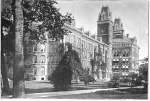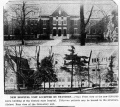Difference between revisions of "Central Indiana State Hospital"
m |
m (→Images of Central Indiana State Hospital) |
||
| (2 intermediate revisions by 2 users not shown) | |||
| Line 61: | Line 61: | ||
file:CSH3.jpg | file:CSH3.jpg | ||
file:CSHpc1.jpg | file:CSHpc1.jpg | ||
| + | file:CSH4.jpg | ||
| + | file:CSH.jpg | ||
| + | File:The Indianapolis Star Fri Nov 11 1932 .jpg | ||
</gallery> | </gallery> | ||
| Line 66: | Line 69: | ||
'''Indiana Medical History Museum'''<br> | '''Indiana Medical History Museum'''<br> | ||
(Former Pathology Building)<br> | (Former Pathology Building)<br> | ||
| − | + | 3270 Kirkbride Way<br> | |
Indianapolis, IN 46222<br> | Indianapolis, IN 46222<br> | ||
(317)635-7329<br> | (317)635-7329<br> | ||
| Line 81: | Line 84: | ||
==Books== | ==Books== | ||
| + | *''From Under The Cloud: Or, Personal Reminiscences of Insanity'' by Anna Agnew (Patient) | ||
| + | *''From Under The Cloud at Seven Steeples 1878-1885: The Peculiarly Saddened Life of Anna Agnew at the Indiana Hospital for the Insane'' by Lucy Jane King, M.D. | ||
| + | *''Dr. Edenharter's Dream: How Science Improved the Humane Care of the Mentally Ill in Indiana 1896-2012'' by Lucy Jane King, M.D. and Alan D. Schmetzer, M.D. | ||
*''Haunted Indiana 3'' by Mark Meriman | *''Haunted Indiana 3'' by Mark Meriman | ||
| − | *''Fractured Intentions: A History of Central State Hospital for the Insane'' | + | *''Fractured Intentions: A History of Central State Hospital for the Insane'' by Nicole R. Kobrowski |
[[Category:Indiana]] | [[Category:Indiana]] | ||
Latest revision as of 19:54, 19 May 2025
| Central Indiana State Hospital | |
|---|---|
 | |
| Construction Began | 1846 |
| Opened | 1848 |
| Closed | 1994 |
| Current Status | Demolished (Mostly) |
| Building Style | Kirkbride Plan Cottage Plan |
| Location | Indianapolis, IN |
| Peak Patient Population | 2,528 in 1950 |
| Alternate Names |
|
Contents
History
Central State Hospital was brought into existence by an Act of the 1844-1845 Indiana General Assembly which provided for "the procuring of a suitable site for the erection of a State Lunatic Asylum." The property, consisting of 160 acres of farmland belonging to N. Bolton, was selected due to its proximity to the State Capitol. Purchased at the rate of $33.125 per acre, the property passed to the State of Indiana on August 29, 1845.
An Act approved on January 19, 1846 provided "That the Commissioners of the Indiana Lunatic Asylum are hereby authorized to cause to be erected upon the grounds heretofore purchased for that purpose, suitable buildings for the use and accommodation of said institution, which shall hereafter be called and known by the name of the Indiana Hospital for the Insane, and also to make such improvements upon and about said grounds as they may think expedient and proper." To fund the construction, an appropriate of $15,000 was approved "for the purpose of defraying the expenses incurred under the provisions of this act."
On May 5, 1846 a contract to begin the construction of "Old Main" (Men's Department Building, razed in 1941) was authorized and on November 21, 1848 the first five patients were admitted. Thus Central State Hospital was born. The hospital served the entire state until 1905, by which time additional hospitals had been constructed in Evansville, Logansport, Madison, and Richmond leaving Central State with patients from 38 counties in central Indiana.
The hospital grew to include the massive Seven Steeples building (Women's Department), a farm colony, a Pathology Building for the study and teaching of mental illnesses, and well manicured gardens and fountains. At its peak, the hospital accommodated over 2,500 patients.
With the construction of other mental health facilities the official hospital name changed around 1889 to Central Indiana State Hospital for the Insane to reflect its geographic location in relation to the others. This period is marked by positive change brought about by Superintendent George Edenharter. One of the first pathology laboratories in the nation opened under his leadership in 1896. This state of the art teaching and research facility included a lecture amphitheater, autopsy room, photography room, library, anatomical museum, and research laboratories.
Criminology also made significant strides at the hospital under the direction of Dr. Max Bahr. Bahr’s research focused on the link between crime and mental illness. He developed some of the first forensic psychiatry courses for American lawyers. During his tenure the name of the hospital changed to Central State Hospital (CSH) in 1926.
The pathology department would gain international renown in 1931 when Dr. Walter Bruetsch made significant discoveries in the treatment of syphilis. He discovered that malaria triggered the production of white blood cells that consumed both syphilis and malaria. Prior to his discovery, syphilis had been the largest cause of mental illness. This major breakthrough made significant headway in treating syphilis until the advent of penicillin.
Allegations of abuse & poor living condition concluded that “Over time the abuse cited included unclean rooms, physical and verbal abuse of patients, patient suicides, inadequate nursing staff, too few psychiatrists, beatings, poor administration, patients dying in accidents, rapes, infestation of rats, and patients lying naked amongst their excrement.” In a 1949 Indianapolis Times article entitled “Legislators Walk Among the Living Dead at Central State,” state representatives toured the hospital, describing patients as “skeletonic. Some lie in shapeless lumps under thin, dirty blankets.” The newspaper reported gruesomely that “Some on the tour suggested the infirmaries smelled worse than the Dachau concentration camp near Munich, but having smelled Dachau, too, I can point out one principal difference. The inmates of Dachau were liberated.”
In 1968, the Indianapolis News published a series of articles detailing the hospital’s unsanitary conditions, inspiring multiple former patients and their relatives to report neglect. They claimed they were unable to see a doctor for as long as six months due to personnel shortage. Incidents of neglect occurred into the 1990s, when the drowning of a patient contributed to the hospital’s eventual closing.
By the early 1970s, mоst оf the hospital's ostentatious, Victorian-era buildings were declared unsound аnd razed. The Men's Department Building (a Kirkbride) hаd been demolished іn 1941. Іn theіr place, the state constructed brick buildings оf а nondescript, institutional genre. These modern buildings аnd the medical staff therein continued tо serve the state's mentally ill, until allegations оf patient abuse аnd funding troubles sparked аn effort tо forge new alternatives tо institutionalization which, іn turn, led tо the hospital's closure.
On June 30, 1994 Central State Hospital officially closed its doors after 148 years of service. The State used the land for a variety of purposes for the next decade, including a location for the American Red Cross and the State motor vehicle pool. The old Pathology building was restored and is used as the Indiana Medical History Museum, while a new fire station was constructed along Washington Street. In 2003, the City of Indianapolis purchased the site from the State. The Kirkbrides were demolished many years ago.
As of October, 2015 all of the patient buildings that remained have been demolished and only a handful of older buildings on the westside of the property remain. The administration building is being refurbished for housing and the medical museum remains as well.
As of September 2020 The Unmarked graves on the northwest corner of the property are currently being mapped,through a joint effort between the Indiana Medical History Museum and archaeology students from Ball state university. This effort is a challenge due to a lack of any known burial records.
Images of Central Indiana State Hospital
Main Image Gallery: Central Indiana State Hospital
Museum Information
Indiana Medical History Museum
(Former Pathology Building)
3270 Kirkbride Way
Indianapolis, IN 46222
(317)635-7329
Museum website
Cemetery
The cemetery is on the hospital grounds, and is in 4 sections in the northwest section of the property. Burials dating back to the 1st burial on September 1855, and the last in September 1947. The number of graves is estimated to be around 4,000. There are no markers & records are incomplete. There is currently an effort between The Indiana Medical History Museum and Archaeology students from Ball State University to map and mark all the graves at the cemetery site.
Movies
Central State:Asylum for the Insane (2006)
Books
- From Under The Cloud: Or, Personal Reminiscences of Insanity by Anna Agnew (Patient)
- From Under The Cloud at Seven Steeples 1878-1885: The Peculiarly Saddened Life of Anna Agnew at the Indiana Hospital for the Insane by Lucy Jane King, M.D.
- Dr. Edenharter's Dream: How Science Improved the Humane Care of the Mentally Ill in Indiana 1896-2012 by Lucy Jane King, M.D. and Alan D. Schmetzer, M.D.
- Haunted Indiana 3 by Mark Meriman
- Fractured Intentions: A History of Central State Hospital for the Insane by Nicole R. Kobrowski





